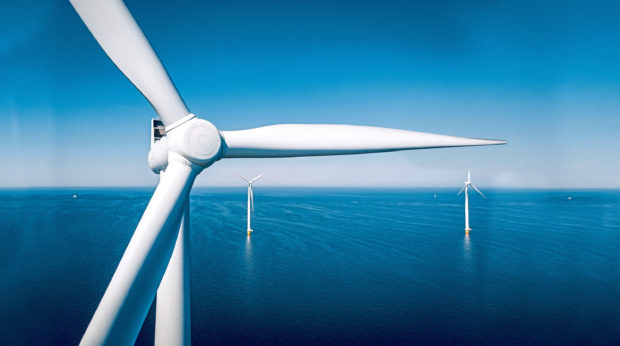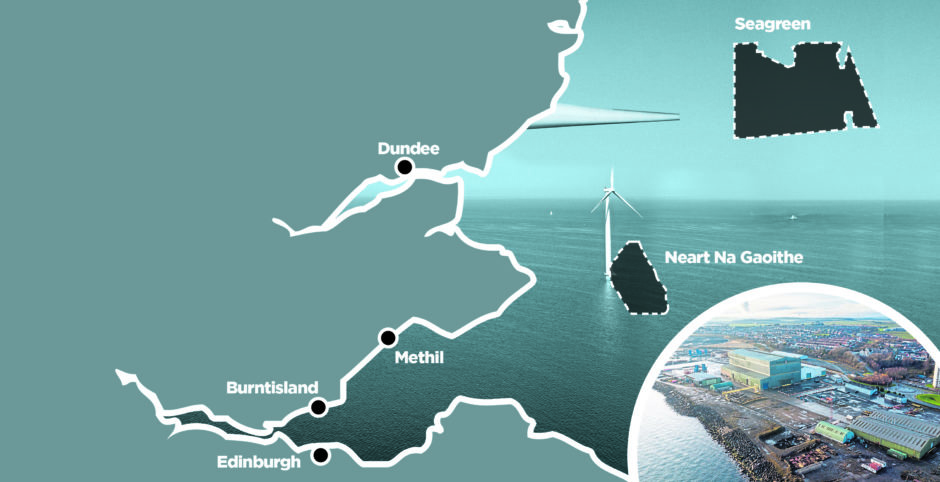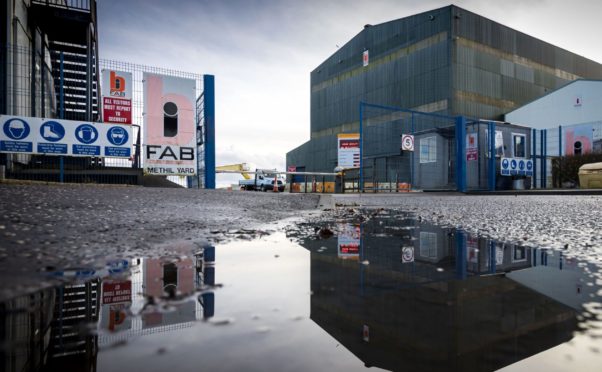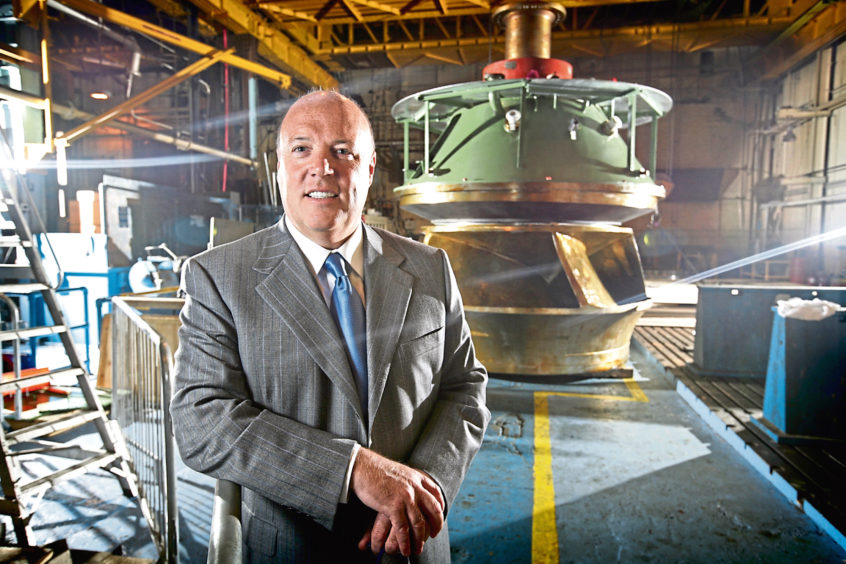
On a clear day, construction work on the giant Neart Na Gaoithe (NnG) wind farm can be seen from the coast of Fife but none of the 54 turbines will now be built in the desolate BiFab yards less than 10 miles away.
Ten years after Alex Salmond predicted Scotland would become the Saudi Arabia of renewable energy, the engineering work for the NnG project has gone to firms in China, the United Arab Emirates and Indonesia. The turbines, once built here and shipped around the world, will be assembled in Dundee, but that work will support just 100 jobs.
It’s a far cry from the then first minister’s forecast that, after North Sea oil, green energy would be Scotland’s next boom industry.
And, while a 2010 report for the Scottish Government predicted wind energy could create up to 28,000 jobs here, the most recent figures show about 3,400 people work in the sector.
Industry experts, academics and trade unions point to a variety of reasons for the failure to gain a foothold in the international market for big engineering contracts with some fearing the dream of building a new manufacturing sector around green energy is already over.
Pat Rafferty, Unite Scottish secretary, said: “The prediction of 28,000 jobs being created is probably right but they are not here. They are in the United Arab Emirates, Indonesia or Spain – everywhere but here. That will only continue unless we start to make investments.
“We need to sit down with the Scottish Government and find out if they are actually genuine about wanting to create a manufacturing base for the green jobs recovery.”
Nick Sharpe, director of strategy for industry body Scottish Renewables, says the problem is due to a lack of strategic thinking and investment across the whole of the UK, going back decades.
He said: “The UK has, for many decades, lacked an industrial strategy focused on maintaining and developing home- grown manufacturing capacity. While other countries have supported businesses that can deliver this kind of work, the UK has, to a large extent, not done so.
“It becomes incredibly difficult, in that environment, to develop local manufacturing that can compete in a global market like offshore wind.”
He said a recent report into offshore renewable energy found UK-made components were 10% to 15% more expensive than the most competitive global price.
He said: “In a situation where the UK Government’s competitive auction process has driven the cost of offshore wind energy below the wholesale price of electricity it is extremely challenging for developers to build these projects using large amounts of local content if that price differential is so large.”
Experts also cite the drive to push down renewable electricity costs. Jamie Stewart, deputy director at the Centre for Energy Policy at Strathclyde University, said: “What has happened at BiFab in a way symbolises the challenges faced in the past decade by the whole renewable energy industry here.
“We have seen the price of renewables coming down and, on top of that, there is a continual drive to push down the costs of producing electricity even further.
“Manufacturers here have struggled to compete with companies from overseas and part of that is to do with economy of scale. In other parts of the world there are some much bigger operations and some get a lot of state support.”
He did see grounds for optimism with offshore wind energy being the biggest area of renewable growth and one that could provide many jobs – but not in traditional manufacturing.
“We may have to accept that, although we have struggled to compete on the manufacturing side, we still have a lot of other positives to offer in terms of jobs – such as the use of our ports, health and safety expertise learned from the oil and gas sector, data use, and our management skills – and make a strategic decision to develop those instead.”
John Macaskill, director of offshore wind consultant firm OWC, agreed that the UK’s higher costs and the small size of its manufacturing sector made it difficult to compete.
He believes traditional manufacturing work to be a high-risk area, citing a number of large overseas firms who have lost money or even gone bust while trying to build turbine jackets at cut-throat prices. He said contracts like the ill-fated deal for BiFab to build jackets for eight of the NnG turbines showed the scale of the problem, not the possible solution.
He said: “It is a low margin segment of the offshore wind value chain with high risks, and you need scale and volume. How can a small Scottish yard doing eight jackets compete? I would not invest my money in that part of the value chain and it is not the place for Scotland to make bets on either.
“Scotland has a proud legacy of engineering, technology and service, especially in the oil and gas sector. We need to get over the white elephant of jacket manufacture and compete where we do well.”
But he does not think that manufacturing should be abandoned, saying: “I sincerely don’t think that UK industrial and economic policy is well suited or aimed at engineering and manufacturing as we are living through the result of decades of Westminster focus on financial services, services and property development as drivers of the economy.
“This is obvious folly and it has impacted areas of England as much as it has Scotland. It needs an entirely new industrial policy overhaul, something that is not really in Scotland’s gift.”
The pace of offshore wind farm installation has also been slower than predicted, with less than a tenth of the generating capacity which would have supported 28,000 jobs built so far – but much more is coming.
Scotland’s coastal waters are already home to five operational offshore sites, with a further four under construction, including the £3 billion Seagreen development of 114 turbines off the Angus coast which, when completed, will be the country’s largest wind farm; three approved for construction and two planned. Only when all 14 are up and running they will have a combined power generation close to that predicted in the 2010 report.
That generation capacity will be doubled when a further 15 wind farm sites, in deeper waters, are developed by the early-2030s.
Mr Macaskill said: “We have not had a lot of offshore wind projects in series, so actually we have not yet had a decent domestic market to build businesses on.”
Stuart McIntyre, head of research at the Fraser of Allander Institute, said efforts had been made in recent years to strengthen UK manufacturing in the wind energy sector – driven partly by frustration over the disappointing economic benefits from renewables.
But, he said: “While there has been a lot of policy focus on high-end manufacturing and manufacturing innovation in recent years in Scotland, there has arguably been much less emphasis on ensuring the resilience of what you might call core manufacturing.”
Dylan Ryan, a lecturer in Mechanical and Energy Engineering at Edinburgh Napier University, also cited the sector’s slim profit margins as holding firms back. He said: “The wind energy market is pretty competitive right now, the costs for offshore wind have been dropping quite significantly and inevitably in such a market you are going to get winners and losers. BiFab is not the first, nor will it be the last, company to fail in this industry. I’d also note that even a turbine made abroad will still need to be assembled and ultimately maintained in the UK, which gives room for plenty of jobs here.
“The Scottish Government’s targets have to be seen as aspirational. They are a bit behind, yes, but so long as they keep making steady progress to their goals that’s what matters.”
With political will, Scotland could be a major energy exporter
by Mark Ruskell, Scottish Greens MSP
The news that BiFab has gone into administration shows the yawning gap between Scottish Government rhetoric and the action needed to realise Scotland’s renewables potential.
The promise to create “the Saudi Arabia of renewables”, with 28,000 offshore wind jobs by 2020 was eye-catching, but there has been a lack of concerted action to achieve the vision.
It would be a mistake to see this as a failure of renewable energy to deliver, because offshore wind farms are being built in our waters right now. It’s a failure of both UK and Scottish governments to strategically invest and create the right conditions to deliver jobs in the UK supply chain.
Scotland has incredible renewable energy potential and there is a strong pipeline of wind power projects, as well as the enormous potential of tidal energy. We need to make sure that comes with a Scottish jobs guarantee.
Scotland has around a quarter of the entire wind energy resource of Europe, just waiting to be harnessed. With the right infrastructure to build on this potential, we could be a major international exporter of clean energy.
But it will require a renewed political will from both the UK and Scottish governments.
Energy policy is reserved to Westminster and there is no doubt that the “contracts for difference” scheme has driven manufacturing work overseas. But the Scottish Government cannot hide behind this and EU rules on state aid.
If Scotland is going to build a greener future and secure thousands of manufacturing jobs, it needs the strategic investment of the state. This is what other countries are doing. It’s what Scotland did after the war when the state built the many hydroelectric schemes that still power our homes today.
It’s a question of priorities, and with the world warming at a rate above what the Paris Agreement agreed was safe, there’s no time to lose.
Last week saw Denmark join the growing number of countries that have ended exploration for new oil and gas. In the UK, we need to choose the renewable path to a safe future and deliver the jobs needed to build it.
Scots companies must have better support to win in European market
by Jim McColl, engineering entrepreneur
The Scottish Government agreed to put up a guarantee for BiFab but then withdrew it because it would be against EU state aid rules. This is a common problem in Scotland and the UK.
Other European countries have national investment banks, which are government backed but also raise third-party finance on the bond markets. Because they are raising third-party money, they can put up guarantees that get round state aid rules.
I do not see why the Scottish Government would not be able to say all it is doing is providing a guarantee the same way other countries do it.
It may be viewed technically as state aid, but that does not mean that it can’t be done.
My view is the Scottish Government should not have backed out of the guarantee to BiFab. If challenged, it should have braved it out.
The Scottish National Investment Bank announced its first deal last month, but does not yet have in place third-party funding or the facility to give guarantees.
To do this, it will need approval from the Treasury and to obtain that there are various hurdles to go through.
I believe this needs to be fast-tracked because when we come out of Europe, and as we come out of this Covid-19 pandemic, we are going to need all the help we can against foreign competition to win work for Scottish companies.
There are a lot of offshore wind projects planned for Scotland but the supply chain in Scotland at the moment is zero. We need to find a way for Scottish companies to be able to take part in these projects, and to do this they need a robust system in place to provide guarantees.
There is a huge market out there for BiFab but it needs the financial support in place by way of guarantees.
I don’t think the Scottish Government interprets state aid rules in the way that other countries do. They take a very, very cautious and timid approach, and in the interests of Scottish businesses and the Scottish economy I believe they need to adopt a more confident and courageous approach.
Jim McMcoll is Clyde Blowers founder and CEO

Enjoy the convenience of having The Sunday Post delivered as a digital ePaper straight to your smartphone, tablet or computer.
Subscribe for only £5.49 a month and enjoy all the benefits of the printed paper as a digital replica.
Subscribe



 © FRASER BREMNER
© FRASER BREMNER © Ashley Coombes/Epicscotland
© Ashley Coombes/Epicscotland